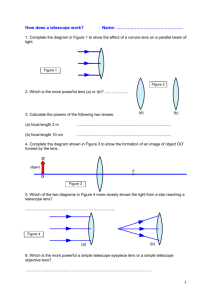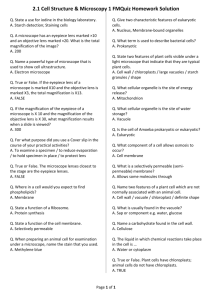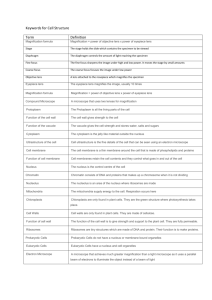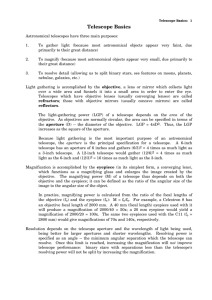Physics 102
advertisement
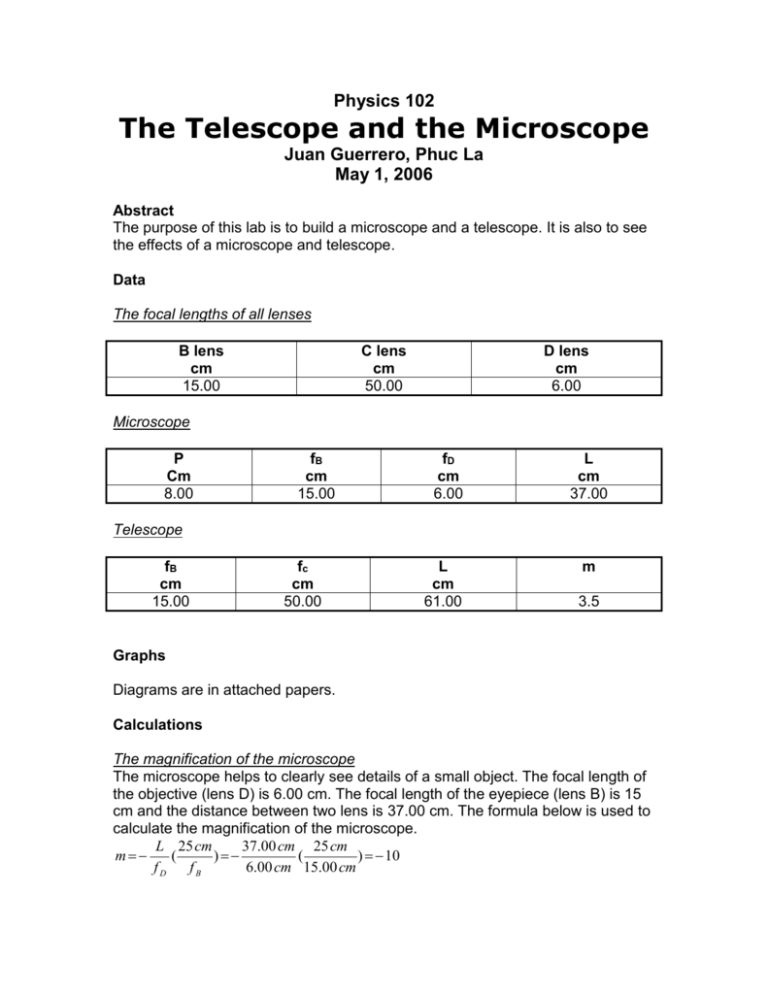
Physics 102 The Telescope and the Microscope Juan Guerrero, Phuc La May 1, 2006 Abstract The purpose of this lab is to build a microscope and a telescope. It is also to see the effects of a microscope and telescope. Data The focal lengths of all lenses B lens cm 15.00 C lens cm 50.00 D lens cm 6.00 Microscope P Cm 8.00 fB cm 15.00 fD cm 6.00 L cm 37.00 Telescope fB cm 15.00 fc cm 50.00 L cm 61.00 m 3.5 Graphs Diagrams are in attached papers. Calculations The magnification of the microscope The microscope helps to clearly see details of a small object. The focal length of the objective (lens D) is 6.00 cm. The focal length of the eyepiece (lens B) is 15 cm and the distance between two lens is 37.00 cm. The formula below is used to calculate the magnification of the microscope. 37.00 cm 25 cm L 25 cm m ( ) ( ) 10 fD fB 6.00 cm 15.00 cm The image is eighteen times larger than the object and the negative shows that the image is upside down. The magnification of the telescope The telescope helps to clearly see objects that are far away. With a telescope a person can see things that are far away with detail. The focal length of the objective (lens C) is 50.00 cm. The focal length of the eyepiece (lens B) is 15.00 cm and the distance between the two lens is 61.00 cm. The formula below is used to calculate the theoretical magnification of the microscope. fc 50.00 cm m theo 3.333 f B 15.00 cm The image is four times larger than the object when it is seen without the telescope from the same distance. The image is also inverted. In the experiment, the magnification of the telescope is 3.5 times bigger than the object when it is seen without the telescope. The percent difference between theoretical and experimental magnification is | 3.500 3.333 | % diff *100% 4.888 % 3.500 3.333 2 Results Microscope p cm 8.00 fB cm 15.00 fD cm 6.00 L cm 37.00 m 10 Telescope fB cm 15.00 fc cm 50.00 L cm 61.00 mexp mtheo % diff 3.500 3.333 4.888 % Difference In the experiment, the magnification of the telescope has a theoretical and an experimental magnification. So, the percent difference can be calculated. mexp mtheo % diff 3.500 3.333 4.888 Questions 1. The magnification of a telescope is the ratio of the objective's focal length over the eyepiece's focal length. These rays emerge as a parallel bundle from the ocular. The emergent bundle is inclined to the axis by some angle different from the entrance angle. Since in this situation all images are at infinity, image sizes are not accessible to measure. That is why the telescope magnification is expressed as angular magnification. 2. Although prism binoculars contain converging lenses only, objects viewed with them are seen erect. The image produced by a telescope may be inverted by placing a positive lens between the objective and the eyepiece. When this is done with the astronomical telescope, the normally inverted image is made erect again. The inverting lens inverts the image without changing the telescope's magnification much. 3. Two lenses are directly next to each other. The distance from the object to the objective is p1 and the distance from the image to the object is q1. The objective has the focal length (f0). 1 1 1 f 0 p1 q1 The distance from the image to the eyepiece is p2 and the distance from the new image to the eyepiece is q2. The eyepiece has the focal length (fe) 1 1 1 f e p2 q2 The distance between the objective and the eyepiece is L. So the second equation becomes the equation below. 1 1 1 f e L q1 q 2 Two lens are directly next to each other, so L is assumed to be 0. The above equation becomes 1 1 1 1 1 1 1 f e L q1 q 2 0 q1 q 2 q1 q 2 Two equations are added together to have new equation. 1 1 1 f 0 p1 q1 1 1 1 f e q1 q 2 1 1 1 1 1 1 1 1 f e f 0 q1 q 2 p1 q1 p1 q 2 The distance from the object to the objective is p1. The distance from the second image to the eyepiece is q2. Two lenses are assumed to be one lens. p1 becomes p and q2 becomes q. The focal length of new lens is 1 1 1 1 1 1 1 fe f0 p1 q2 p q f The equation shows the relationship between two lens and the new lens. 1 1 1 f fe f0 Conclusions In the experiment, the microscope helps to see small objects in detail. It creates an image that is much larger then the actual object. The telescope helps to see objects that are far away. The telescope creates an image of the object that looks much larger than what the object would look like with the naked eye. grade: 90/100


